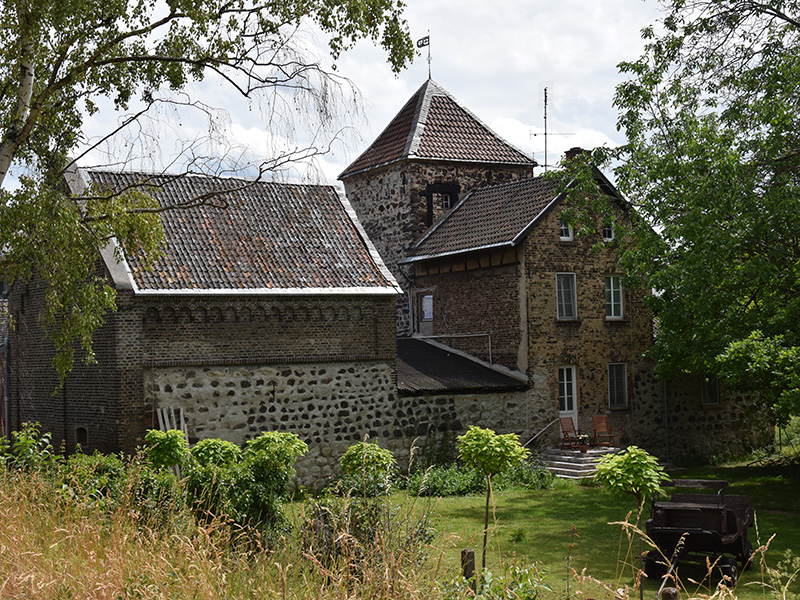5. Projekte Tour: Wolfsburg
HISTORISCHE INFORMATIONEN ZUR WOLFSBURG
Auf dieser Seite erhalten Sie weiterführende Informationen zur Wolfsburg vom Denkmal- und Geschichtsverein Bonn-Rechtsrheinisch e.V.
Die Wolfsburg
Lage und Eigentümer
Die ehemalige Wasserburg, im rechtsrheinischen Bonner Stadtbezirk Beuel, im ehemaligen Ortsteil Vilich-Rheindorf (heute Schwarzrheindorf/Vilich-Rheindorf), ca. 600 m südlich der bekannten Doppelkirche gelegen, ist nach dem Rittergeschlecht der Wolff von Rheindorf benannt. Die Familie gründete hier im 13. Jahrhundert ihren Stammsitz. Im Jahre 1334 wird erstmalig als Besitzer der Ritter Godart von Rheindorf urkundlich erwähnt.
Im 14. Jahrhundert kam die Burg durch Heirat in den Besitz von Johannes von Buschfeld und fiel 1477 durch die Heirat seiner Tochter Margarethe an Arnold von Gymnich. Eine eiserne Wetterfahne mit einem Drachen, dem Wappentier der von Gymnichs, und der Jahreszahl 1597 ziert bis heute den Turm der Wolfsburg, die seit dieser Zeit auch Gymnicher Haus genannt wird. Mit dem Aussterben des Adelsgeschlechts und der Heirat der Witwe des letzten Gymnich mit dem Freiherren von Mirbach ging die Burg in den Besitz der Familie Mirbach über, die sie bis ins 18. Jahrhundert hinein bewohnte und seit 1807 verpachtete.
Die Burganlage
Die ehemalige Ritter- und Wasserburg war ursprünglich eine mehrflügelige Anlage mit Vorburg. Der zentrale fast quadratische Wohnturm der Wolfsburg aus dem 13. Jahrhundert bildet den ältesten Teil der Anlage. Das befestigte Herrenhaus war von einem ca. 9,50 breiten Wassergraben umgeben. An der West-, Süd- und Ostfassade ist das ursprüngliche Mauerwerk aus Drachenfelsgestein (Trachyt) sichtbar. Dieses Steinmaterial, das im Mittelalter Monumentalität ausdrückte, hob die Burg gegenüber den bäuerlichen Holzbauten hervor. Weiteres Baumaterial waren Säulenbasalt und Tuff.
Nach der Zerstörung 1583 im Truchsessischen Krieg (1583 bis 1588 primär zwischen kurkölnischen und bayerischen Truppen ausgetragener Konflikt) erfolgte ein vereinfachter Wiederaufbau der Hauptburg (die Vorburg blieb zerstört). An den ehemals freistehenden Turm wurde im 17. Jahrhundert ein L-förmiger Anbau angefügt. Weitere An- und Umbauten in der zweiten Hälfte des 19. Jahrhunderts und 1932, zum Teil auf alten Fundamenten, ergänzten die Anlage in den folgenden Jahrhunderten, so dass sich die ehemalige Burg heute als ein komplexes Ensemble von unterschiedlichen Gebäudeteilen aus verschiedenen Epochen auf kleinem Raum darstellt.
Die ehemaligen Wassergräben, über die an der Nordseite eine Brücke in den Bereich der Burg führte, wurden erst beim Bau des Hochwasserdeiches 1924 trockengelegt. Zuvor dürfte die Burg bei jedem Hochwasser in einem großen See gestanden haben. Die Wolfsburg weist eine ungewöhnlich umfangreiche und gut erhaltene mittelalterliche Bausubstanz auf. Gemäß archäologischer Erfahrungen bei der Untersuchung ähnlicher Objekte wird ein Vorgängerbau vermutet. Da in näherer Umgebung aber ein Mottenhügel (typisches Relikt frühmittelalterlicher Burgen) fehlt, dürften sich dessen Relikte allenfalls im Untergrund befinden und dann vermutlich relativ wenig zerstört erhalten sein. Zwischen 1998/2000 wurden die südlich und östlich angrenzenden großen Weiden bis relativ dicht an die Burg mit Wohnhäusern bebaut, worunter das optische Erscheinungsbild der denkmalgeschützten Gesamtanlage stark gelitten hat.
Funktion
Die Wolfsburg steht für eine typische Burganlage des niederen Adels, wie sie vom 11. bis 14. Jahrhundert zur Sicherung der errungenen Territorien, u.a. durch die Überwachung der Straßen, häufig entstanden sind. Meist im Tiefland gelegen weisen sie die typischen Merkmale einer Wasserburg auf, sind aber oft nicht mehr als befestigte Häuser. Burgen dieses Typs waren Mittelpunkte kleinerer Herrschaften (Die Wolfsburg war dem Stift Vilich zugehörig, welches zur Unterherrschaft Vilich im kurkölnischen Amt Bonn gehörte), die von den Landesherren an ihre Vasallen vergeben wurden. Die Ritter hatten die Verpflichtung zum Heer- und Hofdienst z.B. des Erzbischofs.
Baudenkmal / Hinweis
Das Objekt „Wolfsburg“ in Bonn-Schwarzrheindorf/Vilich-Rheindorf ist ein eingetragenes Baudenkmal (Denkmalliste der Stadt Bonn, Nr. A 1642) und Bodendenkmal (Denkmalliste der Stadt Bonn, Nr. B 21) sowie wertgebendes Merkmal des historischen Kulturlandschaftsbereichs Rheinaue bei Schwarzrheindorf, Siegmündung (Kulturlandschaftsbereich Regionalplan Köln 438).
Quelle: Kuladig
